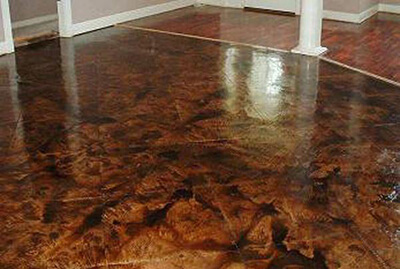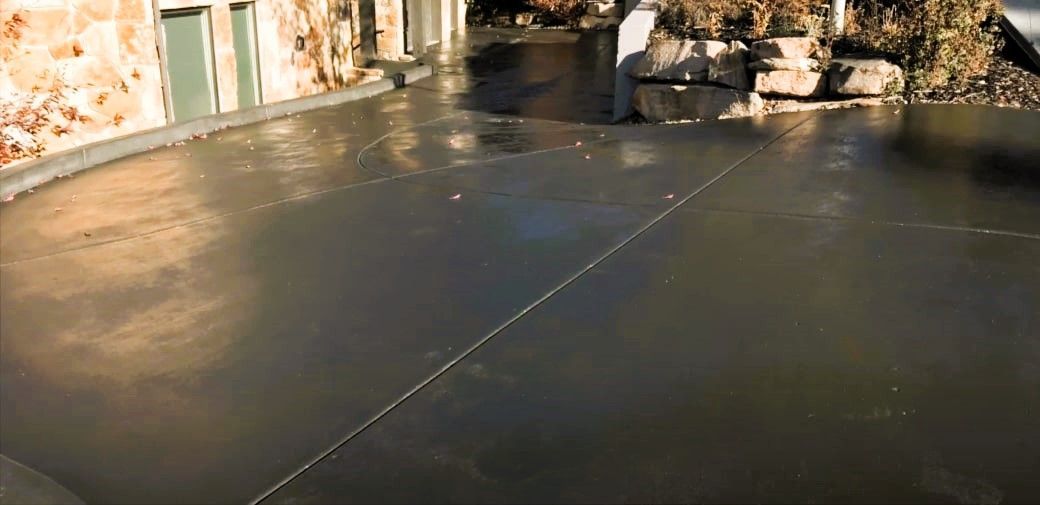Comprehending the Different Kinds Of Stained Concrete for Your Next Job
Stained concrete offers different options that cater to various aesthetic and useful needs. Each kind offers unique attributes that influence the final look and sturdiness of the surface. Understanding these differences is crucial for any person intending a job. From rich, chain reactions of acid-based stains to the vibrant harmony of solid color stains, the options can significantly impact the end result. What variables should one take into consideration when choosing the optimal stain for their details demands?
Introduction of Stained Concrete
Stained concrete functions as a versatile floor covering choice that can improve the aesthetic charm of numerous areas. This technique involves applying a tinting agent to the surface of existing concrete, permitting a broad spectrum of design opportunities. Stained concrete is popular in both domestic and business settings, offering a sturdy and low-maintenance service that can mimic the appearance of natural products like stone or ceramic tile.
The discoloration process can be performed utilizing water-based or solvent-based items, each offering unique visual impacts. The last look is influenced by aspects such as the initial concrete surface, the kind of discolor made use of, and the application approach. Stained concrete not only beautifies insides and outsides but likewise advertises sustainability by rejuvenating existing concrete frameworks. As a result, it has gotten grip among property owners and designers seeking both capability and design in their flooring choices.
Acid-Based Stains: Attributes and Advantages

Special Color Variations
Concrete surfaces can change drastically with the application of acid-based stains, which supply a rich palette of special color variations. These stains permeate the concrete, responding chemically to create lively planet tones that range from deep browns and reds to soft environment-friendlies and blues. The resulting hues are usually variegated, developing an all-natural, marble-like appearance that enhances the concrete's personality. Each application yields unique results because of variants in the concrete's structure and the staining technique used, making every job special. In addition, acid-based stains can be layered or incorporated with other methods to develop tailored layouts, enabling for personal expression. This convenience makes acid-based stains a popular option for both property and business applications.
Chemical Responses Clarified
While several variables add to the performance of acid-based stains, the underlying chemical responses play a vital role in their unique characteristics and benefits. These stains primarily consist of water, acid, and metallic salts. When put on concrete, the acid responds with the calcium hydroxide in the concrete, producing a chemical improvement that causes irreversible shade changes. The metal salts pass through the surface area and bond with the concrete, permitting a wide variety of tones and tones. This response not just improves aesthetic allure yet likewise offers toughness, making the color immune to fading and wear. Furthermore, acid-based stains can create a variegated coating that simulates natural stone, more boosting their appeal for ornamental concrete applications.
Surface Preparation Relevance
Accomplishing ideal results with acid-based stains rests on complete surface prep work. This crucial action guarantees that the concrete surface is clean, cost-free of contaminants, and properly profiled for suitable stain absorption. Any type of existing sealers, dust, or oils can impede the chemical reaction that produces the preferred shade and finish, bring about unequal or patchy outcomes.
Before applying the discolor, the concrete ought to be mechanically cleansed or pressure cleaned, followed by a detailed examination for fractures or blemishes that might call for repair work. In addition, confirming the surface area is sufficiently dried out will improve tarnish adherence. By focusing on these preparatory actions, the longevity and vibrancy of acid-based stains can be substantially improved, leading to a much more cosmetically pleasing and long lasting coating.
Water-Based Stains: Features and Advantages

Water-based stains penetrate the concrete, using an extra clear surface that highlights the all-natural texture and variants of the surface underneath. They are offered in a large range of shades, permitting imaginative versatility in style. Furthermore, water-based stains are easier to tidy up, needing only water and soap, which simplifies the application process.
Their quick drying time improves efficiency, making them a sensible choice for both DIY enthusiasts and experts. On the whole, water-based stains offer an attractive mix of aesthetic convenience and straightforward homes, making them a popular option for concrete enhancement jobs.
Strong Shade Stains: Lively Choices for a Bold Look
Solid color stains use an effective solution for those seeking to create a bold and dynamic aesthetic on concrete surfaces. These stains offer an uniform pigmentation that can drastically improve the visual allure of floorings, outdoor patios, and driveways. Available in a wide range of shades, solid color stains allow for creative expression, satisfying numerous layout choices.
One of the vital benefits of solid color stains is their capacity to hide flaws, offering a fresh and sleek want to maturing concrete - stained concrete floors. Additionally, their solution typically consists of UV-resistant properties, ensuring long life and color retention even in rough climate conditions
Application is straightforward, calling for very little preparation of the concrete surface. Once used, solid shade stains can be secured for added defense and luster, additional elevating their aesthetic high quality. With their vibrant choices, strong color stains are an excellent option for those aiming for an impactful and natural design.
Semi-Transparent Stains: Attaining Depth and Measurement
Semi-transparent stains provide a distinct strategy to improving concrete surfaces by giving depth and measurement through different shade options. Recognizing the application strategies is crucial for accomplishing the wanted effect, while appropriate upkeep practices ensure durability. This section will explore these essential facets to optimize the advantages of semi-transparent staining.
Shade Options Available
A variety of color options exists for semi-transparent stains, enabling homeowners and designers to improve the all-natural elegance of concrete surfaces. These stains come in a variety of tones, from natural tones like browns and terracottas to vibrant colors such as blues and environment-friendlies. The semi-transparent nature of these stains allows the underlying concrete to reveal with, creating a distinct depth and dimension that can match different layout aesthetic appeals. In addition, combining different colors can create custom-made tones, allowing a tailored seek stained concrete each task. This adaptability makes semi-transparent stains a popular choice for both exterior and interior applications, as they can integrate with surrounding components while including aesthetic interest to ordinary concrete.
Application Methods Described
To accomplish the preferred depth and dimension with semi-transparent stains, correct application strategies are important. Surface preparation is crucial; the concrete has to be tidy and totally free of any contaminants. This usually entails power cleaning and repairing any kind of fractures. Next, picking the ideal applicator, such as a sprayer, roller, or brush, can affect the final look. Sprayers permit for an extra even application, while rollers can help attain structure. It is essential to use the discolor in slim, also coats, permitting each layer to dry before including one more. Manipulating the application technique, such as differing pressure or making use of different devices, can create one-of-a-kind impacts. Ultimately, securing the stained surface boosts the vibrancy of the colors while giving defense.
Upkeep Ideal Practices
Regular maintenance is important for preserving the appeal and stability of surfaces treated with semi-transparent stains. To keep these surface areas, routine cleansing is vital. Utilizing a pH-neutral cleaner and a soft-bristle mop will certainly aid get rid of dust and particles without damaging the discolor. It is a good idea to avoid severe chemicals, as they can break down the discolor's look. In addition, periodic resealing every one to 3 years can shield against wear and fading. This process includes cleansing the Visit Website surface area thoroughly and applying a compatible sealant created for stained concrete. Homeowners must likewise keep track of for any signs of staining or damage and address these issues quickly to ensure resilient vibrancy and toughness. Following these best practices will enhance the overall life expectancy of semi-transparent stained surface areas.
Impacts and Techniques: Customizing Your Stained Concrete
Personalizing stained concrete includes a variety of methods that enhance both aesthetics and functionality. Among these approaches, layering various tarnish shades can develop depth and complexity, permitting distinct visual impacts. Methods such as acid staining provide a variegated look, while water-based stains use a much more consistent appearance.
Furthermore, including attractive patterns, such as stenciling or inscription, can additionally customize the surface area, including complex designs that deal with specific preferences. Texturing the concrete, whether with stamping or mop surfaces, presents tactile components that not just improve grip however also enhance aesthetic rate of interest.
Applying sealants can enhance the shade vibrancy and supply protection versus wear. Personalization techniques prolong beyond plain color; they can change a standard concrete piece into a sensational centerpiece, making it appropriate for both domestic and business areas. Via cautious option of impacts and strategies, stained concrete can accomplish a truly customized appearance.
Upkeep and Longevity of Stained Surfaces
Although stained concrete surface areas are known for their durability and visual allure, maintaining their stability is important for guaranteeing longevity. Normal cleansing is important; sweeping and mopping with a pH-neutral cleaner assists stop dirt accumulation and discoloration. In addition, using a sealer every few years can secure the surface area from moisture, chemicals, and UV damage, therefore enhancing its life expectancy.
It is additionally vital to address any cracks or chips immediately. Small repair work can alleviate more deterioration, preserving the visual and structural high quality of the surface. For outdoor stained concrete, seasonal maintenance, such as eliminating snow and ice, is required to stop surface area damages from freeze-thaw cycles.
Regularly Asked Inquiries
Can I Discolor Existing Concrete Surfaces or Just Brand-new Ones?
The question of whether existing concrete surface areas can be stained develops often. It is indeed feasible to discolor both brand-new and old concrete, supplied the surface is sufficiently prepared and cost-free of pollutants for perfect attachment.
The length of time Does the Staining Refine Generally Take?
The discoloration process usually takes one to three days, depending on variables such as surface area prep work, type of helpful hints tarnish, and weather. stained concrete. Curing time might extend past preliminary application, affecting the general period significantly
Is Stained Concrete Safe for Outdoor Usage?
Stained concrete is typically safe for exterior use, gave it is appropriately sealed. This sealing shields against wetness and UV damage, making certain resilience and safety and security, while likewise enhancing the visual charm of outside areas.
Can I Apply Multiple Spot Layers for Various Effects?
Using several tarnish layers can attain varied impacts on stained concrete. It is crucial to guarantee compatibility between stains and permit appropriate drying out time between applications to prevent unexpected responses or staining.
Exist Any Kind Of Shade Limitations for Stained Concrete?
Shade limitations for stained concrete primarily depend upon the kind of tarnish made use of, with water-based stains supplying a more comprehensive palette compared to acid-based stains. local stained concrete. However, achieving vibrant colors might call for mindful option and application methods